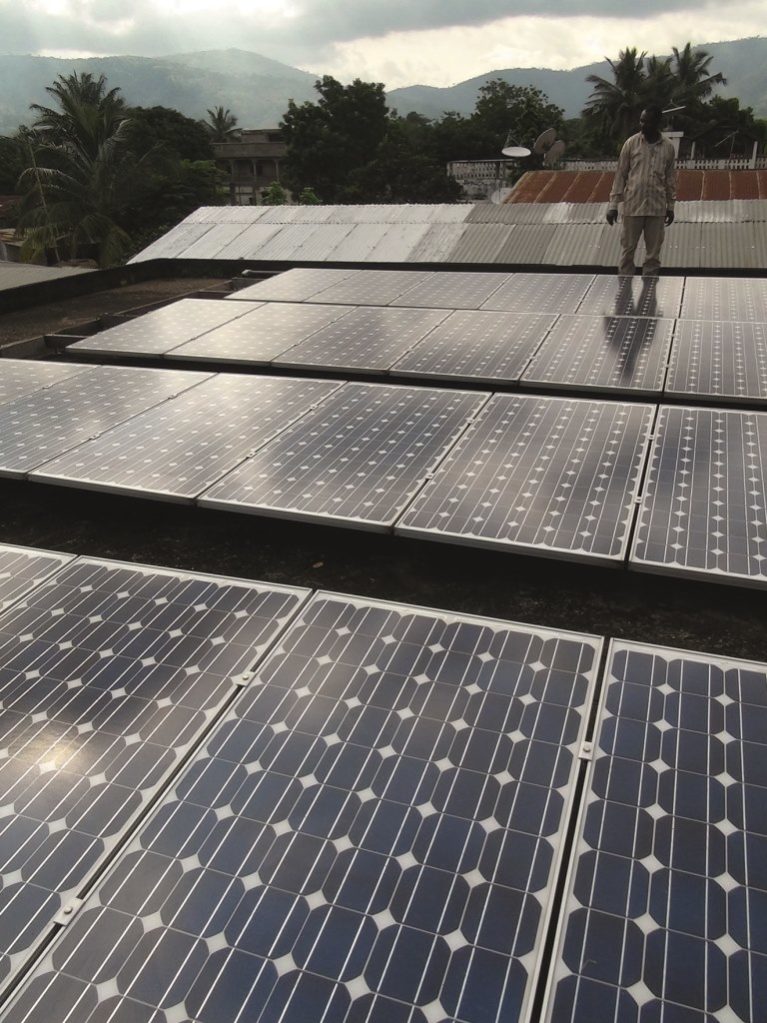As the sun beat down on the roof of a community center in the tiny Togolese village of Wome, the staffers of SunPower Afrique rushed to put on sunscreen. The rays were a reminder that their latest project—the system of solar panels being nailed to the building’s roof—is hot in more ways than one.

Solar panels power a building in Kpalime
The area around Kpalime, Togo’s second-largest city, is hardly the obvious site for a solar energy revolution. SunPower’s business technique—matching solar customers with small microfinance lenders is taking root. The city, tucked into a verdant corner of Togo, is becoming a model for a new energy infrastructure in a country known for its frustrating power shortages.
“Togo has a really strong microfinance community,” says Kira Costanza, SunPower’s founder. “It has more microfinance institutions than other countries. The largest obstacle to solar is the high initial cost”—which can run into the thousands of dollars for just a few panels— “and being able to get a loan.”
The 27-year-old Kira Costanza, the American daughter of a solar engineer, started SunPower in 2007 after living in Kpalime and watching the city and its surrounding villages live with energy shortages. Cuts in the city can stretch from 15 to 24 hours.
War in neighboring Côte d’Ivoire, an energy provider, has also cut Togo’s supply. FECECAV, the Kpalime area’s largest microfinance co-op, was struggling to carry on its business as it dealt with power shortages.
Nearly 80% of Togo’s energy currently comes from biomass, the charcoal and wood burning that destroys forests, and 16% from petroleum products. Existing fuel shortages made Costanza realize that solar power was a competitive and environmentally-sound alternative to gasoline-powered generators.
But how to fund it?
“I worked at FECECAV, and I witnessed first-hand the problem of not having electricity,” Costanza says. “So I decided to start there. I hope it’s something that becomes important to the community.” The problem was finding the financial source needed to begin widespread installation.
Inspiration struck when Costanza began linking schools and homes needing power with the small microfinance institutions, including FECECAV, which dotted the area. The unique alliance—a first for the underdeveloped region—provided both business for the lenders and energy for their clients.
The loans are necessary in a city like Kpalime. The bill for three of SunPower’s rooftop projects in the city totaled $25,000 for panels that could power smaller items like laptop computers and light bulbs.
“For a house, it can hit $10,000, including import and export fees,” she says. “That’s out of reach for most people.”
The test project at FECECAV’s headquarters cost $50,000, with importing, exporting and logistics taking the lion’s share of the cost. (It took nearly a month, and $2,000, to get a recent batch of panels from the US through the Togolese port.)
Costanza and her team are trying to minimize costs so that hospitals, schools, community centers and individual homes will have an easier time taking out loans.
The SunPower team is also working on building solar power systems in a box, which come complete with panels that will be easy to install—and have a cheaper initial cost than the current larger installations.
Besides micro loans, another necessity in Kpalime’s solar evolution has been education.
“In one village, there was no power. We set it up so they could run two laptops and three bulbs at a given time. Then someone wanted to plug in a fridge, which would have fried the system. They don’t understand.”
On the roof in Wome, Koffi Dzodsi, a local resident who serves as the project’s chief technician, worked alongside Dave Staller, an engineer visiting from the US. Together they worked to drill a foundation for panels that were delayed, tied up at the port.
“People here knew about it, but before this they didn’t have financial access to it,” Dzodsi said of the solar technology. “Projects have been going here since 1992 but now there’s a boom because there’s [less] problems with money. There’s a lot of interest.”
SunPower and its success in Kpalime is at the forefront of a solar movement that is quickly growing across Togo and the rest of West Africa.
In 2010, James Gbeho, president of the region’s ECOWAS Commission, said the demand for power across Togo, Benin, Nigeria, Ghana and their neighbors would reach 22,000 megawatts per year in 2020, up from just 6,500 in 2003.
As demand for power grows, governments are struggling to implement renewable energy sources while often working without advanced technology and trying to skirt red tape, namely high importing fees and delays for arriving solar panels. Even when energy is available, it can be too expensive for residents of a city like Kpalime to afford.
Businesses like Costanza’s, which have partnered with local microfinance chapters, have the greatest chance of reaching citizens on the ground level. And the ripple effects of her alternative energy micro-projects are spreading to the highest offices in West Africa. In November, Bukun-Olu Onemola, the Nigerian deputy United Nations envoy, said that nuclear-powered electricity would be a key focus for the country’s president, Goodluck Jonathan, and his “transformation agenda”.
An hour’s Vespa ride from the Kpalime offices of FECECAV, tucked at the base of forested mountains, sits an innocuous village—small and pretty and lacking electricity, like many others in the area.
But look closer; off its dirt roads, a revolution is underway. A hospital, a wealthier two-story home—both have sets of solar panels tucked away, small reminders of the march of Togo’s sun power.
